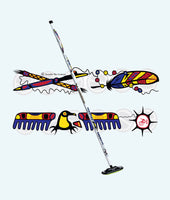#UnitedWeCurl Fiberlite Air Broom: Indigenous Culture
- The Indigenous Culture broom was designed by Greyden Yee Louison as part of the #UnitedWeCurl initiative.
- Proceeds from sales of the Indigenous Culture broom will help support efforts to increase curling participation in Greyden's community.
-
Fiberlite Air Brooms feature a composite handle, and come equipped with an Air Head and Airway Pad.
- The Air Head is certified to meet WCF Specifications when paired with an Air Pro Pad.
The Indigenous Culture broom was designed for us by Greyden Yee Louison from the Kahkewistahaw First Nation. The imagery he has selected is powerful, and you can learn about it as described here in Greyden's own words:
At the top of the broom, I have the sweetgrass and peace pipe.
For the Indigenous people, the peace pipe is looked at as a sacred object. When people go to church, they use the bible to pray to the creator, this is our way to pray to the creator.
Sweetgrass is inserted into the peace pipe and Indigenous people would smoke it for ceremonies and to pray. When the sweetgrass is burned, the smoke from it goes to heaven. This is how they tie together with one another.
Back when our Indigenous leaders met with the government to sign the treaties, the peace pipe was used to sign them.
Going down the broom, the eagle feather is regarded as a sacred gift to have and we wear the eagle feather on our regalia when we dance because it holds a lot of power and strength.
When I was younger, I was told by a teacher who taught me dance that if you do not treat the eagle feather with respect an elder can take it away from you until you have proved that you can look after it. This always stuck with me and I will never forget it.
I put the eagle on the broom because my mom and I always liked seeing bald eagles and we would always stop to take pictures of them because they’re also a sacred animal to Indigenous people.
Another reason why I wanted the eagle on the broom is that on the flag for my reservation, Kahkewistahaw First Nation, that we use to recognize ourselves, there is an eagle.
Lastly, we get to the sun which has the MMIWG red hand logo. This symbol means a lot to Indigenous people, the red hand represents a sad reality that Indigenous women and young girls have no voice in society and we need to protect them because women in my culture are regarded as powerful and known as life-givers because they can give birth to our children.









